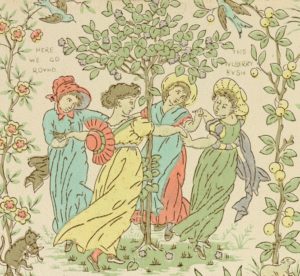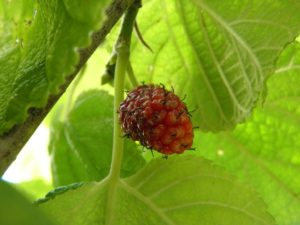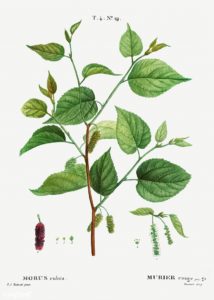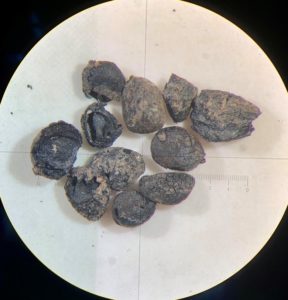 “Here we go round the mulberry bush” is a popular nursery rhyme familiar to many. But how well do you know this summertime fruit staple?
“Here we go round the mulberry bush” is a popular nursery rhyme familiar to many. But how well do you know this summertime fruit staple?
Characteristics:
Mulberries belong to the plant family Moraceae. Red Mulberry (Morus rubra) can be found in the eastern United States flowering during the months of April and May, and fruiting during the months of June, July, and August. White Mulberry (Morus alba) can also be found in the eastern United States flowering in the month of May, and fruiting the months of July and August.
Plants in the family Moraceae, or Mulberry Family, are characterized by trees and shrubs with alternate leaves and milky sap. They produce flowers that are either male or female; these small, tightly clustered flowers either form separately on the same or on different trees. Male flowers have four sepals (or none), four stamens, and no petals, while female flowers have four sepals (or none) and are also without petals. North American members of the Mulberry Family include the genera of Broussonetia (paper mulberry), Fatoua (crabweed), Maclura (osage orange), and Morus (mulberry).

“Morus rubra; Red mulberry”, by Sharpj99, CC BY-NC-SA 2.0.
Red Mulberry is the only species of mulberry native to eastern U.S. Red Mulberry trees are found in floodplains and river valleys, and on moist hillsides, reaching up to 65 feet tall with a short trunk and stout, spreading branches. The branchlets are covered in hairs and they have simple, broad, egg-shaped, and lobed leaves with square bases, a pointed tip, and serrated edges. Mulberries grow aggregate fruits – berries! – that are about 2 to 3 cm long and are dark purple in color when ripe. They can range from sweet to acidic, and are still widely harvested today for jams and pies, or simply to be eaten raw.

“Red mulberry (Morus rubra) illustration from Traitédes Arbres”, Free Public Domain Illustrations by rawpixel, CC BY 2.0.
Historical Uses:
Many Native American peoples have made use of the mulberry tree for centuries. The Cherokee people have used Red Mulberry for fresh fruit, jam, dumplings, and as a juice beverage. They made dumplings by crushing and straining the berries and then mixing them with sugar and cornmeal. White Mulberry (Morus alba) berries were also eaten fresh. Medicinally, the Cherokees used the bark of both Red Mulberry and White Mulberry in an infusion to treat worms, to check dysentery, as a laxative, and/or as a purgative.
The Muscogee (Creek) have utilized the roots of the Red Mulberry as an emetic, a stimulant, or for urinary problems. The root bark has also been used by the Meskwaki people for sickness, and the Rappahannock people have made use of the tree sap to apply on ringworm.
The Comanche and the Omaha peoples have also eaten the Red Mulberry as a fresh fruit. The Seminole have used the plant for food, but also used the branches to make bows for hunting. The Iroquois Haudenosaunee peoples have used mulberries by drying them either by the fire or in the sun, making them easy to take along for hunting or other travels. The berries can also be mashed into small cakes, dried, and stored for later use, or they can be soaked in warm water and cooked as a sauce or mixed with corn bread.

Carbonized mulberry (Morus rubra) seeds under the microscope from the Mussel Beach archaeological site (40MI70) in Tennessee (photo courtesy of Kelly Santana).
In the early 19th century, mulberry trees were seen as a sign of economic prosperity in the United States. White Mulberry leaves are the ideal food for silkworms; the filament produced by silkworms fed on the tougher Red Mulberry leaves was considered inferior in quality. But White Mulberries were relatively easy to propagate and thus were particularly important in the success of the silk industry that boomed during this time. Before the silk industry waned in the mid-19th century, there was a point in time when growing mulberry trees was a more appealing business prospect than the actual production of silk.
Other species of mulberries have also been enjoyed throughout the world. For example, Afghanistan is famous for its pantry staple of dried mulberries. The berries can be utilized as a self-contained tea bag or as a condiment for bread. In fact, originating with caravanning nomads, dried berries were mixed with nuts and pressed into “chakidar”, or nutrient-packed blocks, that would then be tied to the end of the traveler’s turban for a snack.
Mulberry Bread Recipe:
(Recipe from Gastro Obscura: A Food Adventurer’s Guide by Cecily Wong and Dylan Thuras)
Makes 16 Bars
½ pound dried mulberries
½ pound shelled walnuts
¼ teaspoon kosher salt
2 tablespoons water
16 walnut halves for topping
1. Put all of the ingredients except the walnut halves in a food processor fitted with a metal blade and puree for 1 to 2 minutes until they form a thick, smooth, sticky paste.
2. Line an 8 x 8-inch baking pan with parchment or wax paper, with the paper draping over two sides of the pan, to make removing the bars easier.
3. Press the mulberry-walnut mixture into the pan, making an even layer all over the bottom of the pan. Distribute the walnut halves evenly, making 4 rows of 4 walnuts, then gently press them halfway into the mixture.
4. Refrigerate for an hour to firm up the bars. Using the edges of the wax paper, lift the mixture out of the pan and set it on a cutting surface. With a sharp knife, cut it into 16 squares with a walnut in the center of each square. Store in a sealed container at room temperature, or the refrigerator if you prefer them cold.
For More Information:
If you’d like a closer look at a mulberry tree, the UT Arboretum in Oak Ridge is home to Red Mulberry (Morus rubra) off of Cemetery Ridge Trail and Old Kerr Hollow Road. Pack a picnic and try to find it! For even more adventure, download the iNaturalist app and search for Morus rubra in your area. See where mulberry has been sighted near you or post your own sighting for others to see!
References:
Elpel, Thomas J. 1967. Botany in a Day: The Patterns Method of Plant Identification, An Herbal Field Guide to Plant Families of North America. HOPS Press. Pony, MT.
Forest Service, U.S. Department of Agriculture. 1974. Seeds of Woody Plants in the United States. Agriculture Handbook No. 450. Washington, D.C.
Gershon, Livia. 2017. When America Went Crazy for Mulberries. JSTOR. https://daily.jstor.org/when-america-went-crazy-for-mulberry-trees/
Hamel, Paul B., and Mary U. Chiltoskey. 1975. Cherokee Plants and Their Uses—A 400 Year History. Sylva, North Carolina: Herald Publishing.
Moerman, Daniel E. 1998. Native American Ethnobotany. Timber Press, Portland, Oregon.
Perry, Myra Jean. 1975. Food Use of “Wild” Plants by Cherokee Indians. M.S. Thesis, University of Tennessee, Knoxville.
US Department of Agriculture, Natural Resources Conservation Service. 2022. PLANTS Database. Electronic document, https://plants.usda.gov/home.
Wong, Cecily and Dylan Thuras. 2021. Gastro Obscura: A Food Adventurer’s Guide. Workman Publishing. New York.